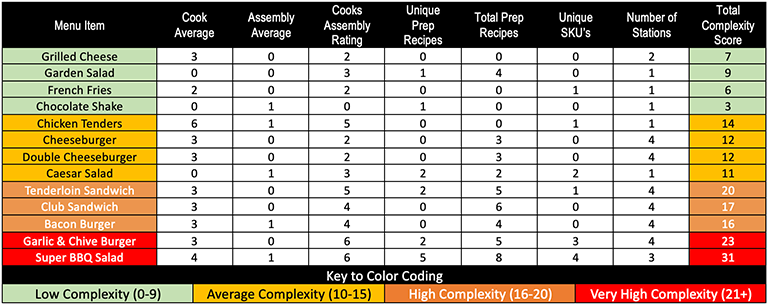Understanding menu complexity scores is important for any restaurant owner as it helps establish a rating for each menu item based on its complexity. The rating is based on seven key factors that play an important role in the profitability of your business.
It’s essential to know your menu complexity scores as that knowledge can have a significant impact on your restaurant’s bottom line. Low-scoring menu items are less complex, while high-scoring ones are more complex.
The seven key factors that determine the complexity score of a menu item are assembly average, cook average, cook assembly rating, total number of prep recipes used, number of unique prep recipes used, number of unique SKUs, and number of stations needed to produce the item. Once the rating numbers for each factor are added up, an overall complexity score for that individual menu item is formed. This exercise is conducted for every item on your menu, and once the complexity scores have been determined, you can use them to your advantage.

Example of a Complexity Score document (partial) developed by a fast-casual chain (menu item details have been edited for confidentiality).
The many benefits of establishing menu complexity scores
By having menu complexity information at your fingertips, you can be sure that you’re always making the most strategic decisions possible to increase your profitability and bottom line.
There are multiple benefits, including:
- Leveraging High Selling + Low Complexity Items. These menu items are your star performers and should be given a high priority on all your menu communications (i.e., mobile app, website, menu board and P2P zone messaging). After all, they are already among your best sellers and they are among your least complex for operations.
- Downplaying Low Selling + High Complexity Items. These menu items should be given a lower profile with customers. Also, explore opportunities to improve the complexity scores. For example, are there more efficient preparation techniques, or would upgraded cooking equipment help? If the improvement of complexity scores is not feasible, these menu items become candidates for elimination from your menu.
NOTE: Conducting a menu total unduplicated reach and frequency (TURF) analysis can determine the risk associated with eliminating an item from your menu. TURF uses consumer research and a mathematical process to statistically determine if the elimination of a menu item would have any negative impacts in satisfying your customers (reach) and how often they might use your brand if that item were eliminated (frequency).
- Optimizing Staffing. Complexity scores give you the ability to better manage staff and make sure that you're not overstaffing or understaffing the kitchen. Keep in mind, labor efficiencies can have an immediate impact on your bottom line.
- Reducing Cost-of-Goods. By better understanding ingredient usage, you can avoid waste and reduce costs.
- Enhancing Operational Efficiency. Awareness of operational complexity scores will lower costs by streamlining operations related to assembly times, cooking times, recipe complexity, ingredient uniqueness, number of assembly steps, stations used, etc.
- Making Continuous Improvements. Complexity scores help identify key improvement opportunities, ensuring that customers consistently receive high-quality meals every time they come to your store. Efficiency improvements will also speed throughput, allowing you to process more customers, faster. This results in higher sales and greater customer satisfaction and loyalty, which translates into customer frequency to help you stay competitive in the marketplace.
Knowing your menu complexity scores will not only help your business today but help your business going forward as you focus on a menu having lower complexity scores that assure more efficient operations and greater profitability.
 AUTHOR BIO
AUTHOR BIO
Howland Blackiston is Co-Principal of King-Casey. For more than half a century, King-Casey has been helping restaurant brands grow their businesses and dramatically improve the customer experience. King-Casey’s solutions are firmly grounded in insights derived from hard data and analytics relative to consumer behavior. King-Casey provides a complete range of menu optimization services including assessment, research, menu reengineering, Menu Strategy, and menu communications. www.king-casey.com





